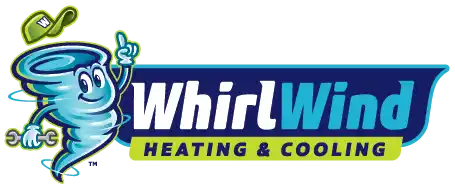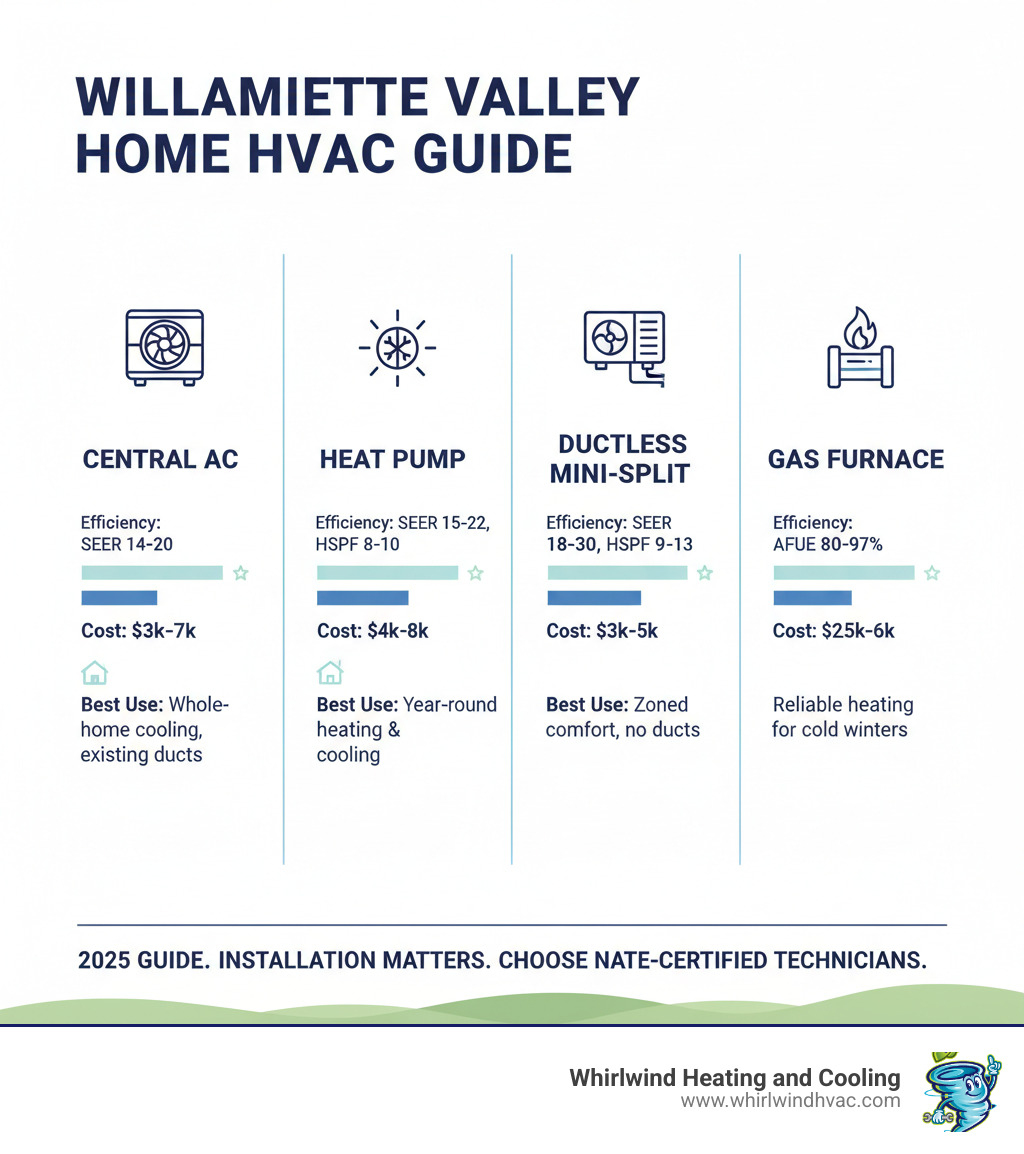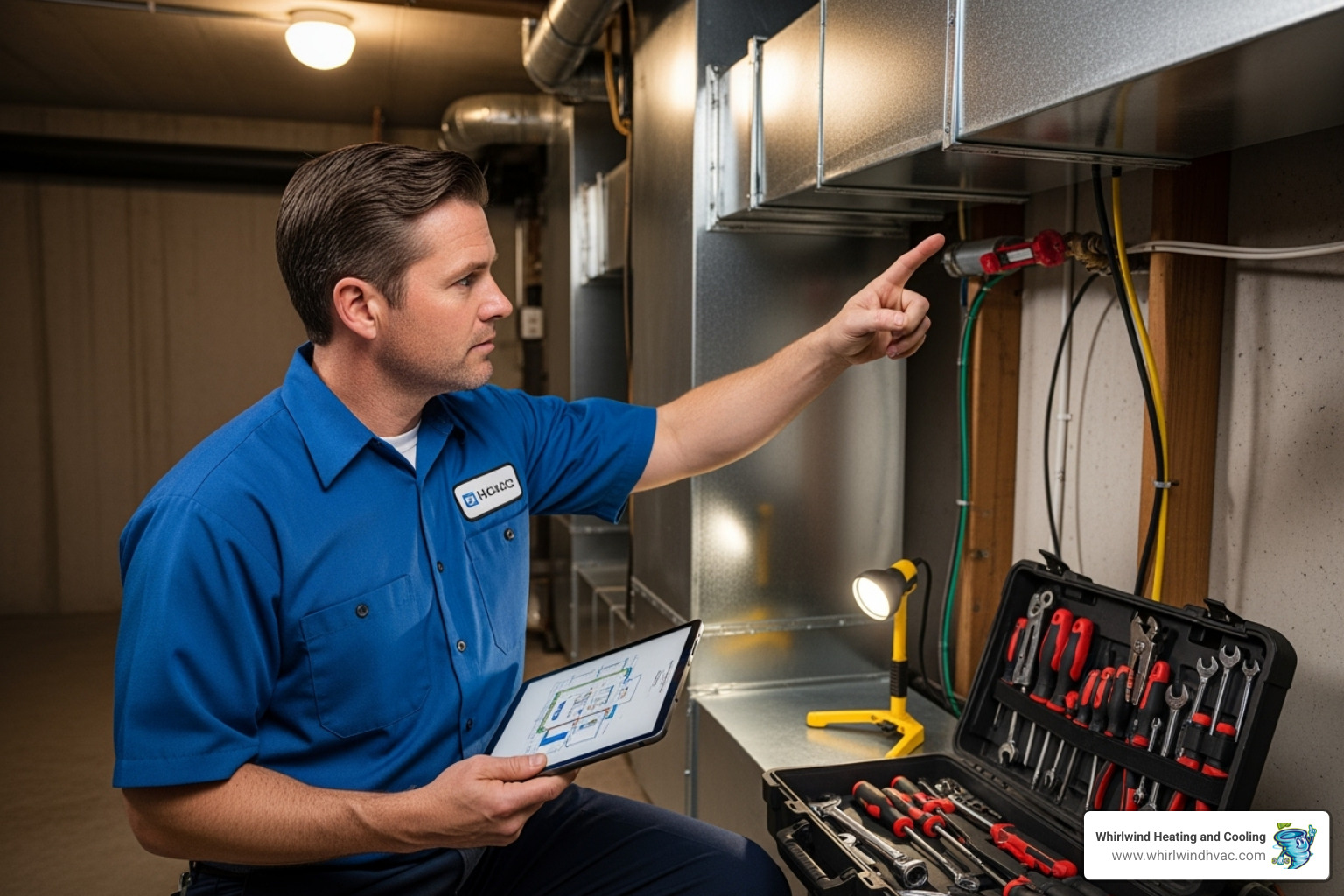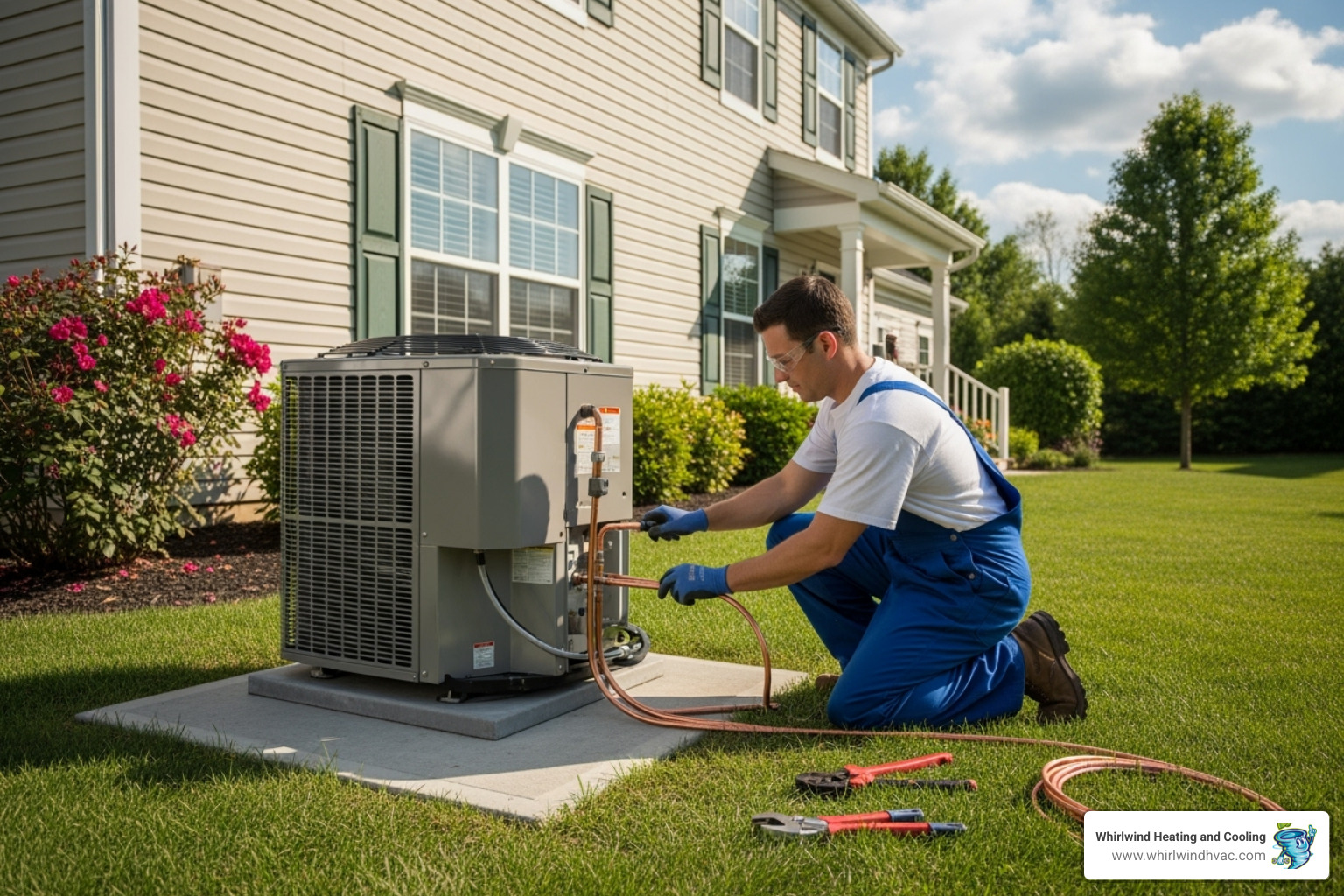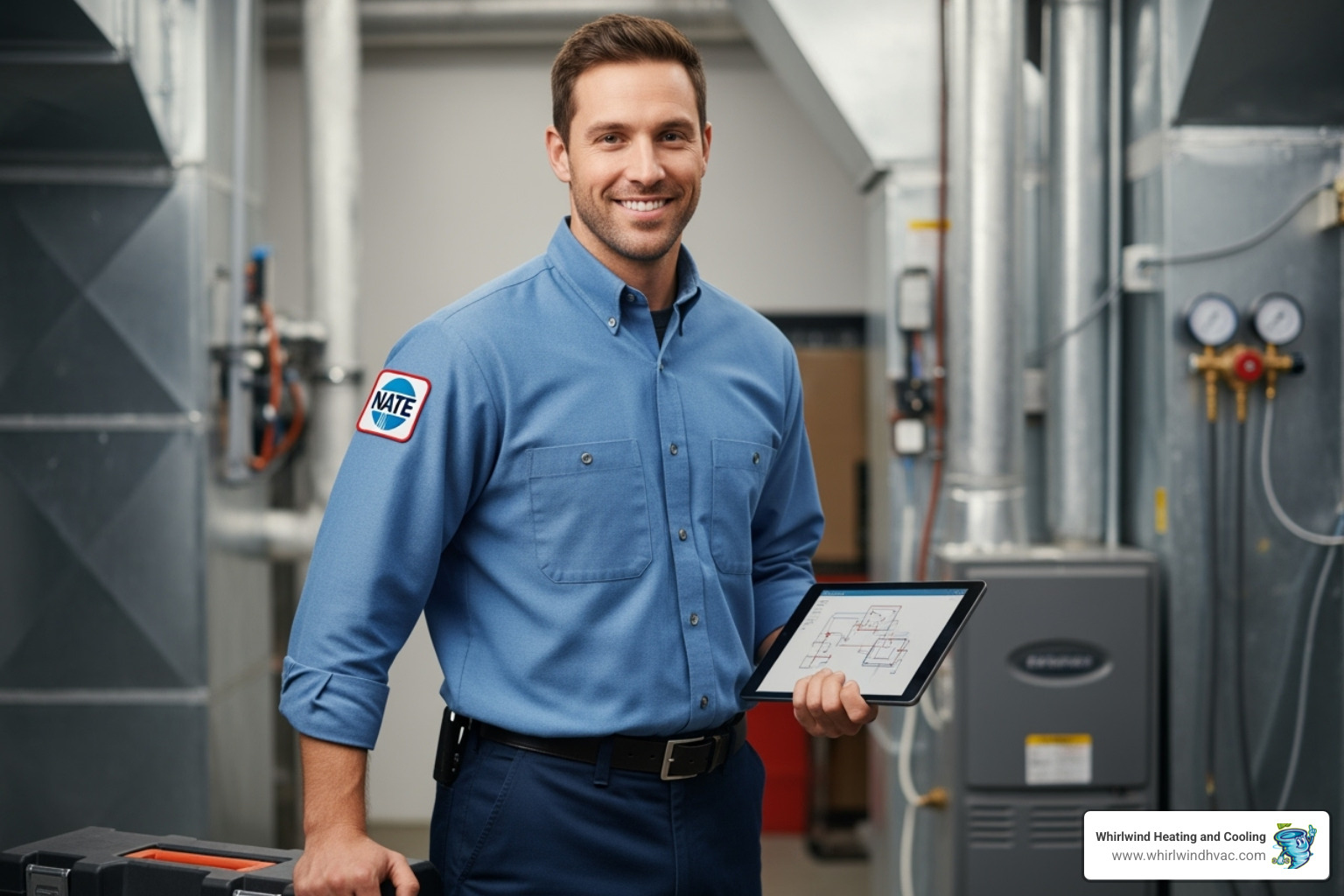Why Local HVAC Installation Matters for Your Home’s Comfort
When your local hvac installation is done right, it transforms your home into a comfortable, energy-efficient sanctuary. But when it’s done wrong, you’re looking at years of high energy bills, inconsistent temperatures, and costly repairs.
Quick comparison of local HVAC installation options:
- Central Air Systems: Best for whole-home cooling with existing ductwork ($3,000-$7,000)
- Heat Pumps: Year-round heating and cooling, energy-efficient ($4,000-$8,000)
- Ductless Mini-Splits: Perfect for targeted zones or homes without ducts ($3,000-$5,000)
- Gas Furnaces: Reliable heating for colder climates ($2,500-$6,000)
HVAC systems last 10-20 years, with most replacements costing between $5,000 and $10,000. As systems become less efficient after a decade, proper installation is critical to maximize your investment.
While regular maintenance can improve system efficiency by up to 15%, it all starts with a quality installation. The most important factor isn’t just what system you choose—it’s who installs it and how they do it.
NATE-certified technicians represent the highest standard in HVAC installation. They have the expertise in proper sizing, load calculations, and installation techniques to ensure your system runs efficiently for 20 years, not just struggles for 10.
Understanding Your HVAC Needs and Options
Planning your local HVAC installation begins with understanding your home’s unique needs. A system that works for your neighbor might not be right for you, especially in the diverse homes of the Willamette Valley. Choosing the right system is a 10-20 year investment in comfort and energy savings. For expert guidance, see our guide on Choosing the Perfect AC Installation.
Comparing HVAC System Types
Let’s walk through the main players in the HVAC world. Each system has its sweet spot, and understanding these differences helps you find your perfect match.
Central Air Conditioning is a classic whole-home cooling solution that uses existing ductwork. It’s often the most cost-effective option if you already have ducts, providing reliable, consistent cooling.
Furnaces are heating specialists, ideal for keeping you warm during damp Willamette Valley winters. Powered by gas, propane, or electricity, modern furnaces are highly efficient at converting fuel to heat.
Heat Pumps are efficient multitaskers, providing both heating and cooling. They move heat rather than creating it, making them an excellent value for our moderate climate.
Ductless Mini-Splits are perfect for homes without ductwork or for creating zoned temperature control. Each indoor unit connects to an outdoor compressor, offering efficient heating and cooling for specific areas like additions or converted garages.
| System Type | Primary Function | Energy Efficiency (Typical) | Best Use Case | Cost Range (Installation) |
|---|---|---|---|---|
| Central Air | Cooling (often paired with furnace) | SEER 13-26 | Whole-home cooling, existing ductwork | $3,000 – $7,000 |
| Furnace | Heating | AFUE 80-98% | Primary heating in colder climates, existing ductwork | $2,500 – $6,000 |
| Heat Pump | Heating & Cooling | SEER 14-23, HSPF 7-11 | Year-round comfort, moderate climates, energy savings | $4,000 – $8,000 |
| Ductless Mini-Split | Heating & Cooling | SEER 16-30, HSPF 8-12 | Zoned comfort, no ductwork, additions | $3,000 – $5,000 |
Key Factors for Your Local HVAC Installation
Matching the right system to your home’s unique characteristics is essential.
Home square footage is just one factor. A well-insulated 1,500-square-foot home needs a smaller system than a poorly insulated one of the same size.
Insulation quality acts like a winter coat for your house, retaining conditioned air. Better insulation means your system works less, saving you money and extending its lifespan.
Window type greatly impacts energy use. Old, single-pane windows lose significant heat, while energy-efficient windows reduce heating and cooling demands.
Our local Willamette Valley climate is moderate, making it ideal for high-efficiency systems like heat pumps, which operate best in our climate’s temperature range.
Existing ductwork condition is key. Good ducts make central air and furnaces viable. If they’re old or leaky, consider ductless systems or budget for duct replacement.
Your lifestyle and comfort preferences also guide system design. Your temperature preferences and daily schedule help us tailor a system that fits how you live.
For a deeper dive into these considerations, take a look at What to Consider Before AC Installation. Getting these factors right ensures your new system will keep you comfortable and save money for years to come.
The Local HVAC Installation Process from Start to Finish
Once you’ve chosen a system, the next step is the local HVAC installation. We believe in a transparent and smooth process from start to finish.
From Consultation to Completion
Your local HVAC installation journey begins with an initial consultation where we discuss your comfort concerns, energy goals, and budget. It’s a conversation focused on understanding your needs, not a sales pitch.
Next, our technicians conduct a thorough in-home assessment and measurements, including a Manual J load calculation. This industry-standard assessment ensures your system is perfectly sized, preventing common performance issues.
After the assessment, you’ll receive a detailed, itemized quote with no surprise costs. We break down all costs—unit, labor, and materials—and explain each line item so you can invest with confidence.
We then schedule the installation date at your convenience, aiming to minimize disruption while our team prepares to transform your home’s comfort.
The process begins with careful old system removal, ensuring proper disposal and recycling of all components. Our goal is a Seamless Heater Installation from start to finish. Learn more at What to Expect: Furnace Installation.
What to Expect During Your Local HVAC Installation
On installation day, our team takes every precaution to protect your home, using drop cloths and shoe covers and treating your space with respect.
Equipment placement follows a careful plan, with new units positioned according to manufacturer specifications and local codes for optimal performance and longevity.
Our team handles any necessary ductwork modifications with precision. Upgrading ductwork with a new system maximizes efficiency and performance.
Our NATE-certified technicians use specialized tools to safely complete electrical and refrigerant line connections according to code. These vital connections are done without shortcuts.
Once connected, we perform system testing and calibration, checking airflow, temperatures, and safety controls to ensure it operates efficiently and is custom to your home’s needs.
The job concludes with a final walkthrough and user training. We show you how to operate your new system, answer all your questions, and ensure you’re completely confident before we consider the job done. This thorough approach reflects The Importance of Proper AC Installation.
Budgeting for Your New HVAC System
A new local HVAC installation is a significant investment in your family’s daily comfort. While the typical cost of $5,000 to $10,000 for a replacement seems high, it’s a long-term investment over the system’s 15-20 year lifespan. Plus, a new energy-efficient system can save you money on monthly utility bills.
Understanding Installation Costs
Several factors contribute to your final quote:
The equipment itself accounts for 40-60% of the total cost. Higher-efficiency units cost more upfront but deliver long-term savings on your energy bills.
Professional installation labor covers the expertise, tools, and time required for a proper installation, from safe removal of the old unit to calibrating the new one for peak performance.
Your home’s specific needs affect pricing. A simple replacement costs less than a complex one needing new wiring or ductwork. Replacing old, leaky ducts with your new system is a smart, though additional, investment.
System size and complexity also influence cost. Larger homes need more powerful systems, and complex installations like zoned mini-splits require more time and expertise.
Financing, Rebates, and Tax Credits
We can help make your new system more affordable.
We offer financing options to help you spread the cost into manageable monthly payments. Often, the energy savings from your new system can help offset these payments.
Manufacturer rebates can save you hundreds or even thousands. We always check for current seasonal offers when preparing your quote.
Federal tax credits are available for many energy-efficient systems. We can help you identify which models qualify for these government incentives.
Local utility programs, like those from Energy Trust of Oregon, offer additional rebates for high-efficiency upgrades. We can help you steer these programs, or you can explore them at EnergyTrust.org.
The combination of financing, rebates, and long-term energy savings makes a new HVAC system more affordable than it might first appear.
How to Choose the Right HVAC Professional
Choosing the right professional for your local HVAC installation is the most critical step. Even the best system will underperform if installed incorrectly, leading to high bills and breakdowns. A quality installation by an expert contractor ensures your system’s efficiency, longevity, and your home’s comfort for years.
Must-Have Qualifications for an HVAC Installer
When vetting HVAC companies, these qualifications are non-negotiable.
State and local licensing is your first checkpoint. A licensed contractor meets regulatory standards and understands safety codes. Always ask to see the license to avoid unreliable operators.
Proof of insurance is essential. Verify both liability and workers’ compensation coverage to protect yourself from financial responsibility for accidents. A legitimate contractor will provide this readily.
NATE certification is the industry’s gold standard. NATE-certified technicians have passed rigorous, real-world exams, ensuring they have the expertise for a proper installation that results in better performance and fewer issues.
Years of experience in the Willamette Valley is invaluable. An experienced local contractor understands our climate and common housing types, and can handle any unexpected challenges during installation.
Positive customer testimonials provide real-world insight into a company’s professionalism and quality. Check online reviews and resources like the Better Business Bureau when checking company ratings.
Questions to Ask Before Hiring
A reputable contractor will welcome your questions. Vague answers or annoyance are red flags. Ask these key questions:
- Are you licensed and insured? This is a must. We are fully licensed and insured and will happily provide proof.
- Do you have NATE-certified technicians? This shows a commitment to technical excellence, as NATE certification is a voluntary investment in quality.
- Can you provide references from recent installations? A good contractor will have references. Calling them can provide valuable, insight.
- Do you perform a Manual J load calculation? This is crucial for proper system sizing. Skipping it can lead to an inefficient, poorly performing system.
- What warranties do you offer on parts and labor? A strong warranty shows confidence. We stand behind our installations with a 100% money-back guarantee through the first 2 years and a ‘No Lemon’ guarantee on our systems.
- Do you offer maintenance plans? This shows a focus on long-term satisfaction, as regular maintenance is key to system longevity and efficiency.
At Whirlwind Heating and Cooling, our mission is simple: “Do it right, at a fair price.” This commitment guides everything we do, from our first phone call to years of ongoing support.
Post-Installation: Maximizing Efficiency and Lifespan
Congratulations on your new local HVAC installation! Now, the journey to maximize its 15-20 year lifespan begins. Regular maintenance is key, as it can improve your system’s efficiency by up to 15%, lowering bills and preventing issues. For more tips, see our guide on Smooth Heat Pump Installation.
Essential HVAC Maintenance
Simple maintenance tasks can make a huge difference in your system’s performance and longevity.
Changing air filters is the easiest and most impactful task. Clogged filters force your system to work harder. Check filters monthly and replace them every 1-3 months—more often if you have pets or allergies.
Keeping the outdoor unit clear of debris is also crucial. Your outdoor condenser needs to breathe. Regularly clear away leaves and debris, maintaining at least two feet of clearance around the unit.
Scheduling annual professional tune-ups allows our technicians to perform a deep-dive health check. We inspect refrigerant levels, clean internal components, lubricate parts, test controls, and check for duct leaks to ensure optimal performance.
Checking vents and registers for blockages inside your home is also important. Ensure furniture, rugs, or curtains don’t block supply and return vents, as clear airflow is essential for even air distribution.
Signs Your System Needs Repair or Replacement
Even well-maintained systems eventually wear out. Be aware of these warning signs, especially if your system is over 10 years old.
- Unusual noises or odors: Grinding, squealing, or banging sounds are calls for help. Musty smells may indicate mold, while other odors can signal mechanical issues.
- Weak airflow: Reduced airflow from your vents can signal blower issues, ductwork problems, or a refrigerant leak.
- Inconsistent temperatures: Hot and cold spots suggest your system is struggling. This could be due to thermostat or ductwork issues, or a failing system.
- Rising energy bills: A sudden spike in costs without a clear reason indicates your system is losing efficiency and working too hard.
- System is over 10-15 years old: If your older system shows these signs, replacement may be the most cost-effective option. Efficiency drops significantly after a decade, and a new system is often a better investment than frequent repairs.
Frequently Asked Questions about HVAC Installation
Thinking about a new local HVAC installation brings up many questions. We encourage them, as an informed homeowner is a happy one. Here are answers to some of the most common questions we hear.
How long does a typical HVAC installation take?
A straightforward replacement typically takes 1 to 2 days. More complex projects, such as those requiring new ductwork or home modifications, can take up to a week. The exact timeline depends on the system type and complexity of the job. We provide a clear timeline during our consultation and always prioritize quality over speed.
Is a bigger HVAC system always better for my home?
Absolutely not. This is a common and costly myth. An oversized system will “short cycle”—turning on and off frequently. This leads to poor humidity control, inconsistent temperatures, and premature wear on components. Proper sizing using a Manual J load calculation is crucial. This scientific process analyzes your home’s unique features to determine the exact capacity needed, ensuring efficient and effective operation.
What are the main services offered by local HVAC companies?
As a full-service HVAC company, we handle all aspects of your home’s air comfort and quality. Our main services include:
- New System Installation: We install furnaces, air conditioners, heat pumps, and ductless mini-splits.
- Emergency Repairs: We’re available for urgent repairs when your system fails unexpectedly.
- Routine Maintenance: We offer plans to keep your system running efficiently and prevent major issues.
- Indoor Air Quality Solutions: We install air purifiers, humidifiers, and other systems to improve the air you breathe.
- Ductwork Services: We provide duct inspection, sealing, and replacement.
- System Design: We design complete HVAC systems for new construction and major renovations.
Conclusion
Navigating a local HVAC installation can be a straightforward and rewarding process with the right professional support. By understanding your options, the installation process, and how to budget, you can transform your home’s comfort, lower energy bills, and increase its value.
The key to a successful HVAC system is quality installation. A properly sized and expertly installed system guarantees years of reliable comfort, lower energy costs, and peace of mind. This investment in professional craftsmanship is what makes the difference.
The long-term benefits are significant. A modern, high-efficiency system can cut energy use by 20-40%, while also providing quieter operation, better humidity control, and improved indoor air quality. It’s an upgrade that also boosts your home’s value.
At Whirlwind Heating and Cooling, our reputation is built on our mission: “Do it right, at a fair price.” We treat every installation with the care we’d give our own family’s home, ensuring your Willamette Valley home is comfortable year-round.
Ready to experience what a truly professional local HVAC installation can do for your home? Contact us for your HVAC installation needs in the Willamette Valley and let’s get started on creating the comfortable, efficient home you deserve.

